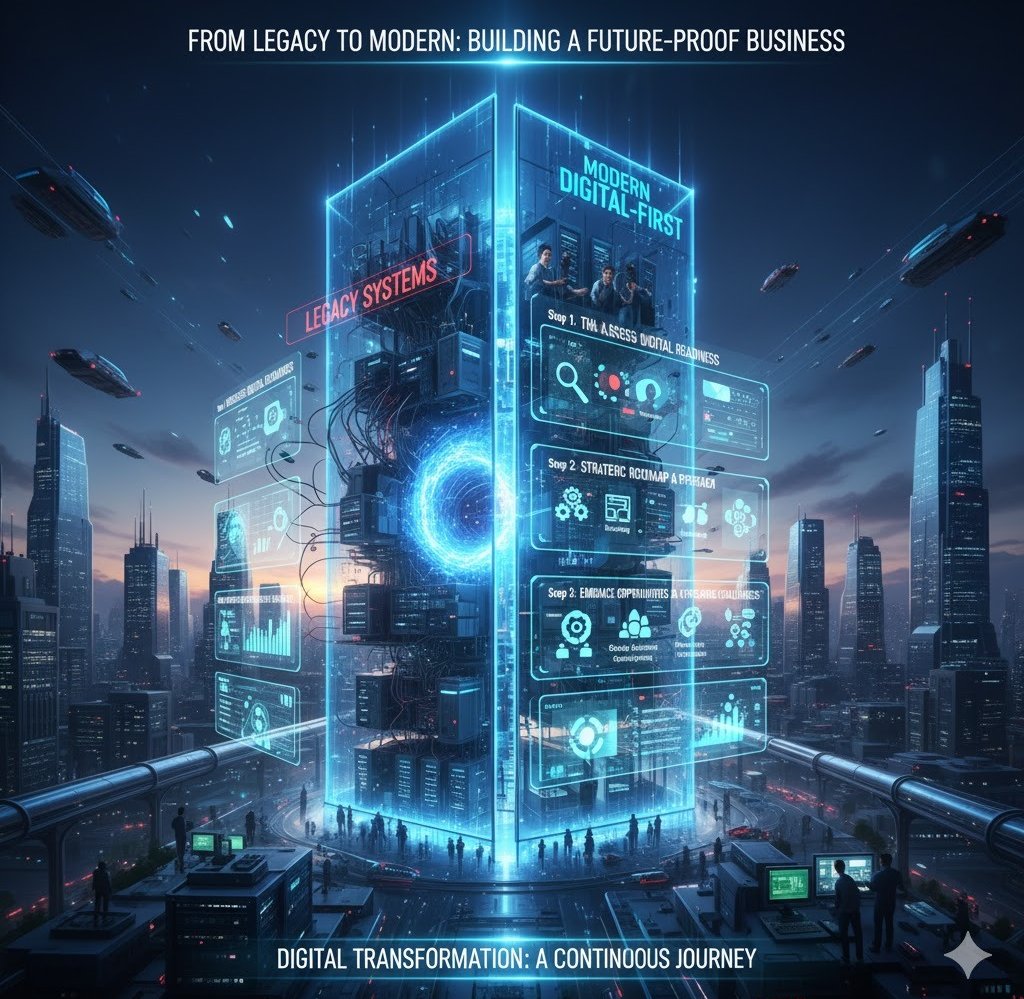From Legacy to Modern: The Roadmap to Digital Transformation
Mr. Diyan Ahmed
10/11/20253 min read


SEO Idea: A high-level, strategic post for businesses still operating on older systems. It provides a clear roadmap for transitioning to a more modern, digital-first operation, covering the challenges, the opportunities, and the steps to building a sustainable and future-proof business.
SEO Keywords: digital transformation strategy, business modernization, legacy system migration, digital readiness, change management, technology adoption, digital-first, future-proof business, IT modernization.
Is your business still running on outdated systems and manual processes? Many companies find themselves in this position, weighed down by legacy systems that are inefficient, expensive to maintain, and a roadblock to innovation. The journey from legacy to modern can seem intimidating, but it's a necessary step toward building a sustainable and future-proof business. This is the essence of digital transformation, and it's less about a one-time tech upgrade and more about a complete, strategic overhaul of your business.
This roadmap will provide a clear, step-by-step guide for making the transition, highlighting key challenges and the immense opportunities that await.
Step 1: Assess Your Digital Readiness 🧭
Before you can build a new future, you need to understand your present. The first step in any digital transformation strategy is a comprehensive audit of your current systems, processes, and culture.
Identify Pain Points: Where are your biggest inefficiencies? Is it slow data retrieval, manual tasks that cause errors, or a lack of real-time insights? These are the areas that will provide the greatest return on investment (ROI) once modernized.
Analyze Your Technology: What are your current systems? Are they cloud-based or on-premise? Are they compatible with modern applications? A thorough assessment will help you determine what needs to be replaced, refactored, or integrated.
Evaluate Your Team: Is your workforce prepared for new technologies? The human element of change management is the most critical part of digital transformation. A lack of training or buy-in from employees can cause even the best-laid plans to fail.
Step 2: Develop a Strategic Roadmap and Choose Your Approach
Once you have a clear picture of your starting point, it's time to create a detailed plan. Your digital transformation strategy should be broken down into manageable phases, with a clear focus on achievable goals.
For legacy system migration, there isn't a single solution. You need to choose an approach that fits your business needs and risk tolerance. Common strategies include:
Rehosting (Lift-and-Shift): Moving applications to the cloud with minimal changes. It's the fastest and lowest-risk approach, but it may not fully leverage the benefits of the cloud.
Replatforming: Moving to a new platform with minor adjustments to optimize performance.
Refactoring/Rearchitecting: Completely rebuilding the application to take full advantage of cloud-native features and modern architecture. This is the most complex approach, but it offers the greatest long-term benefits.
Step 3: Embrace the Opportunities and Overcome Challenges
Technology adoption is not without its hurdles. Businesses often face financial constraints, a lack of in-house expertise, and resistance from employees who are comfortable with the old way of doing things. The key is to manage these challenges proactively.
Change Management: Openly communicate the "why" behind the transformation. Emphasize how the new tools will make employees' jobs easier and more efficient. Provide comprehensive training and create a culture that embraces continuous learning and innovation.
Start Small: Don't try to transform everything at once. Begin with a high-impact pilot project that can demonstrate a quick win and build momentum for the larger effort.
Strategic Partnerships: You don't have to go it alone. Partnering with experienced digital transformation consultants can provide the expertise, support, and guidance needed to navigate the complexities of modernizing your business.
Conclusion: A Continuous Journey to a Digital-First Future
Transitioning from a legacy to a modern, digital-first business is a journey, not a destination. It requires a clear vision, a solid digital transformation strategy, and a commitment to continuous improvement. By proactively addressing challenges and embracing the opportunities of business modernization, you can create a more agile, efficient, and resilient organization that is not only prepared for the future but is also actively shaping it.
Most Important Change Management Deliverables in a Digital Transformation
This video is a YouTube video about change management deliverables in digital transformation, which is a key part of the blog's topic.
Connect
Partnering for innovation across industries.
Explore
Discover
+923001534092
© 2025. All rights reserved.
